Southwest Airlines: Technology Failure and Management Strategies
VerifiedAdded on 2021/05/31
|17
|4412
|377
Report
AI Summary
This report provides a comprehensive analysis of a major technology failure experienced by Southwest Airlines Co., a leading U.S. airline. It delves into the details of the computer outage, its financial and non-financial repercussions, and the airline's response. The report explores relevant theories and models, including Crisis Management theory, Communication and employee engagement, Business Continuity Management, and Kotter’s eight-step model for change management, to understand the impact of the failure on various aspects of the organization, such as employees, operations, business strategy, and revenues. It identifies the problem using brainstorming and root cause analysis. As a solution, the report recommends implementing a blockchain strategy to mitigate the impact of future technical failures, supported by a detailed action plan. The report concludes with recommendations and references to support the analysis.
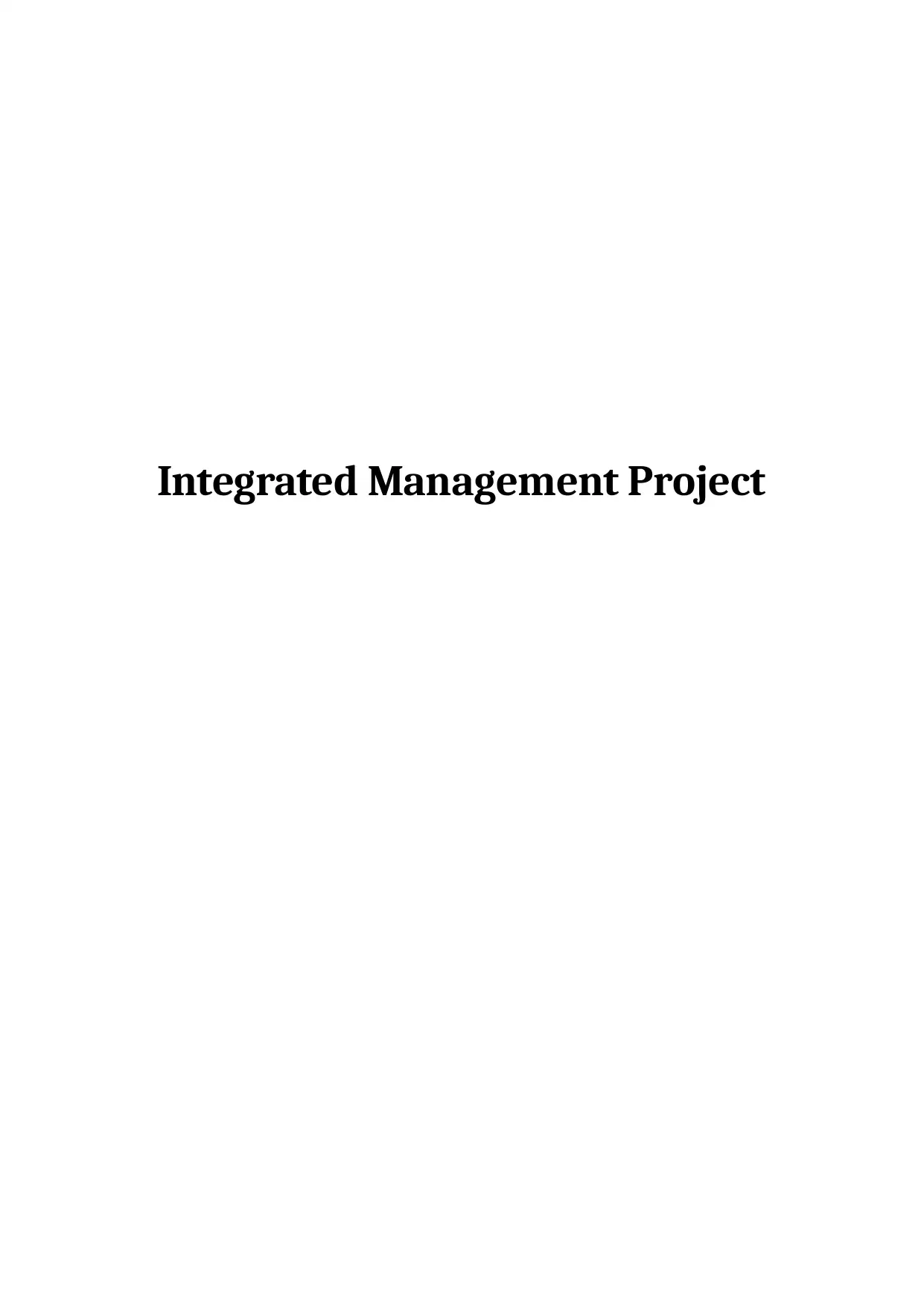
Integrated Management Project
Paraphrase This Document
Need a fresh take? Get an instant paraphrase of this document with our AI Paraphraser
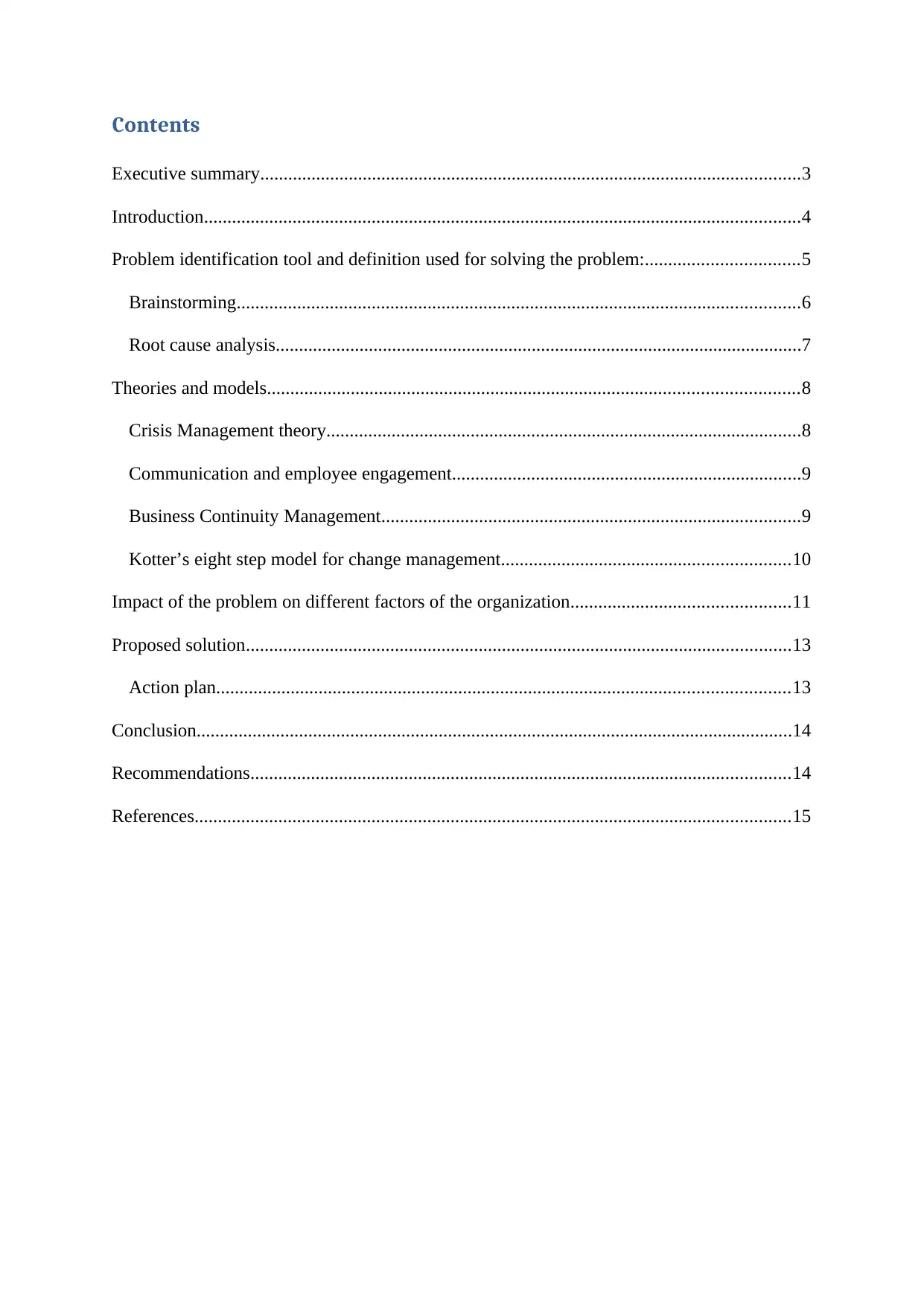
Contents
Executive summary....................................................................................................................3
Introduction................................................................................................................................4
Problem identification tool and definition used for solving the problem:.................................5
Brainstorming.........................................................................................................................6
Root cause analysis.................................................................................................................7
Theories and models..................................................................................................................8
Crisis Management theory......................................................................................................8
Communication and employee engagement...........................................................................9
Business Continuity Management..........................................................................................9
Kotter’s eight step model for change management..............................................................10
Impact of the problem on different factors of the organization...............................................11
Proposed solution.....................................................................................................................13
Action plan...........................................................................................................................13
Conclusion................................................................................................................................14
Recommendations....................................................................................................................14
References................................................................................................................................15
Executive summary....................................................................................................................3
Introduction................................................................................................................................4
Problem identification tool and definition used for solving the problem:.................................5
Brainstorming.........................................................................................................................6
Root cause analysis.................................................................................................................7
Theories and models..................................................................................................................8
Crisis Management theory......................................................................................................8
Communication and employee engagement...........................................................................9
Business Continuity Management..........................................................................................9
Kotter’s eight step model for change management..............................................................10
Impact of the problem on different factors of the organization...............................................11
Proposed solution.....................................................................................................................13
Action plan...........................................................................................................................13
Conclusion................................................................................................................................14
Recommendations....................................................................................................................14
References................................................................................................................................15
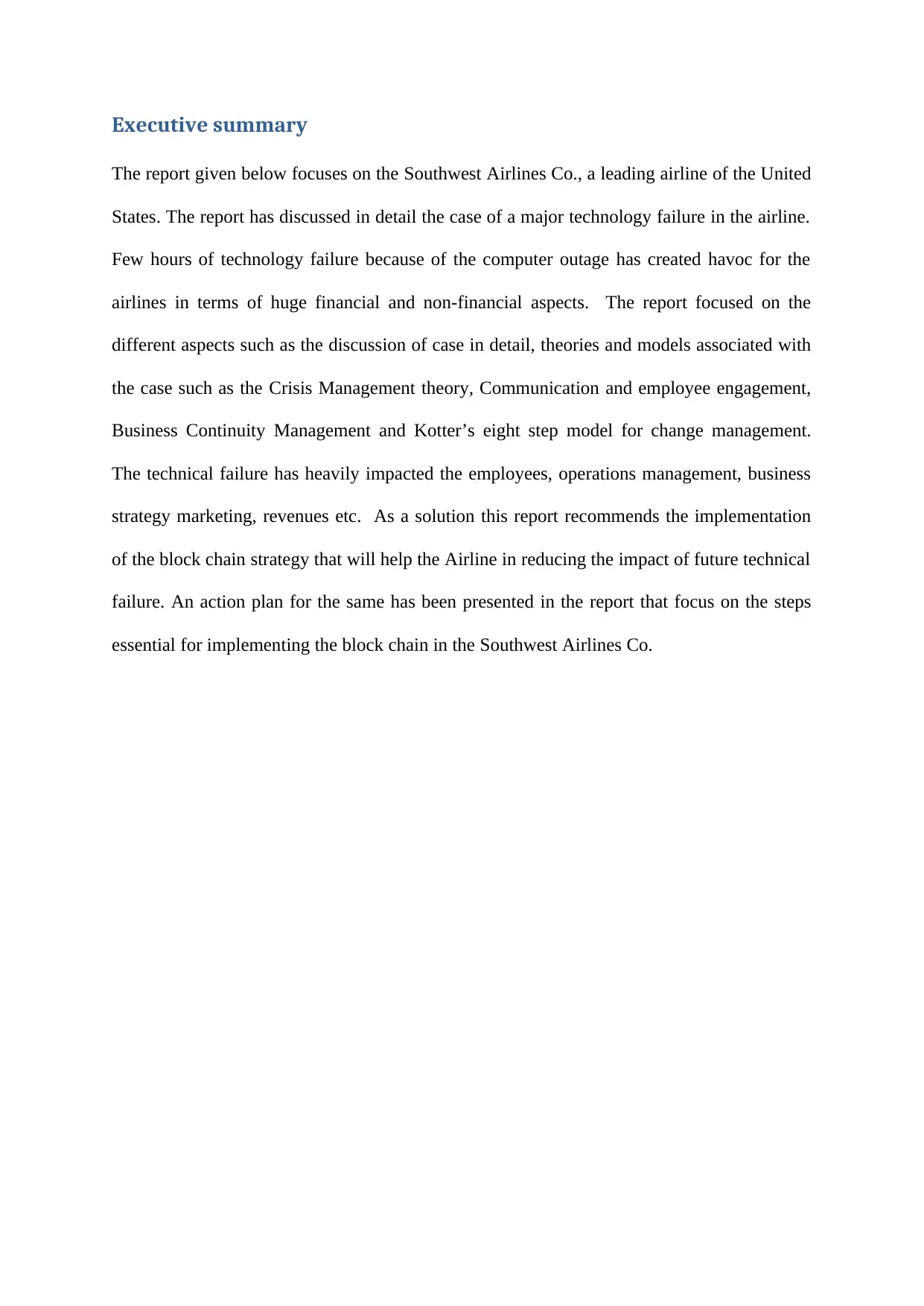
Executive summary
The report given below focuses on the Southwest Airlines Co., a leading airline of the United
States. The report has discussed in detail the case of a major technology failure in the airline.
Few hours of technology failure because of the computer outage has created havoc for the
airlines in terms of huge financial and non-financial aspects. The report focused on the
different aspects such as the discussion of case in detail, theories and models associated with
the case such as the Crisis Management theory, Communication and employee engagement,
Business Continuity Management and Kotter’s eight step model for change management.
The technical failure has heavily impacted the employees, operations management, business
strategy marketing, revenues etc. As a solution this report recommends the implementation
of the block chain strategy that will help the Airline in reducing the impact of future technical
failure. An action plan for the same has been presented in the report that focus on the steps
essential for implementing the block chain in the Southwest Airlines Co.
The report given below focuses on the Southwest Airlines Co., a leading airline of the United
States. The report has discussed in detail the case of a major technology failure in the airline.
Few hours of technology failure because of the computer outage has created havoc for the
airlines in terms of huge financial and non-financial aspects. The report focused on the
different aspects such as the discussion of case in detail, theories and models associated with
the case such as the Crisis Management theory, Communication and employee engagement,
Business Continuity Management and Kotter’s eight step model for change management.
The technical failure has heavily impacted the employees, operations management, business
strategy marketing, revenues etc. As a solution this report recommends the implementation
of the block chain strategy that will help the Airline in reducing the impact of future technical
failure. An action plan for the same has been presented in the report that focus on the steps
essential for implementing the block chain in the Southwest Airlines Co.
⊘ This is a preview!⊘
Do you want full access?
Subscribe today to unlock all pages.

Trusted by 1+ million students worldwide
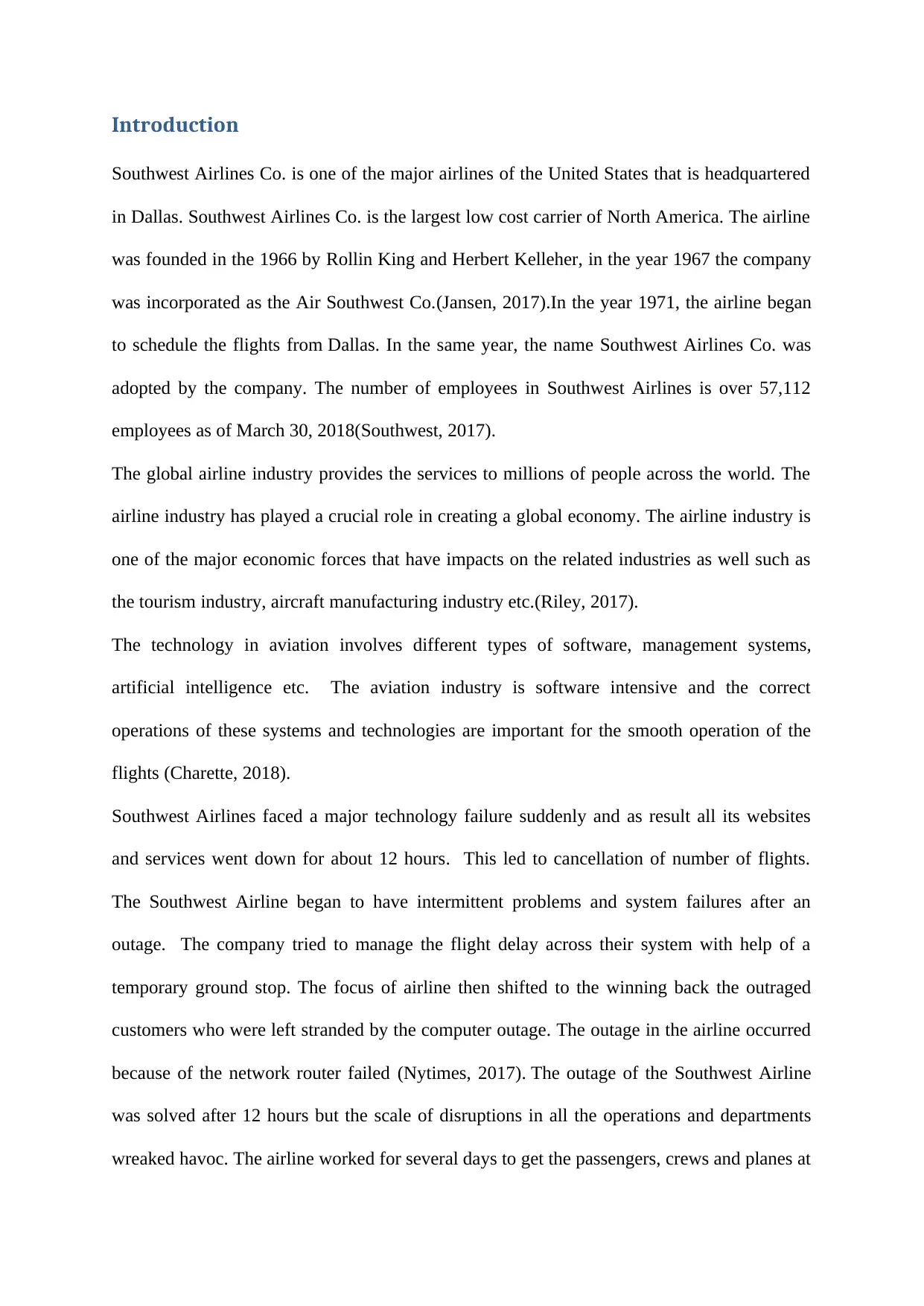
Introduction
Southwest Airlines Co. is one of the major airlines of the United States that is headquartered
in Dallas. Southwest Airlines Co. is the largest low cost carrier of North America. The airline
was founded in the 1966 by Rollin King and Herbert Kelleher, in the year 1967 the company
was incorporated as the Air Southwest Co.(Jansen, 2017).In the year 1971, the airline began
to schedule the flights from Dallas. In the same year, the name Southwest Airlines Co. was
adopted by the company. The number of employees in Southwest Airlines is over 57,112
employees as of March 30, 2018(Southwest, 2017).
The global airline industry provides the services to millions of people across the world. The
airline industry has played a crucial role in creating a global economy. The airline industry is
one of the major economic forces that have impacts on the related industries as well such as
the tourism industry, aircraft manufacturing industry etc.(Riley, 2017).
The technology in aviation involves different types of software, management systems,
artificial intelligence etc. The aviation industry is software intensive and the correct
operations of these systems and technologies are important for the smooth operation of the
flights (Charette, 2018).
Southwest Airlines faced a major technology failure suddenly and as result all its websites
and services went down for about 12 hours. This led to cancellation of number of flights.
The Southwest Airline began to have intermittent problems and system failures after an
outage. The company tried to manage the flight delay across their system with help of a
temporary ground stop. The focus of airline then shifted to the winning back the outraged
customers who were left stranded by the computer outage. The outage in the airline occurred
because of the network router failed (Nytimes, 2017). The outage of the Southwest Airline
was solved after 12 hours but the scale of disruptions in all the operations and departments
wreaked havoc. The airline worked for several days to get the passengers, crews and planes at
Southwest Airlines Co. is one of the major airlines of the United States that is headquartered
in Dallas. Southwest Airlines Co. is the largest low cost carrier of North America. The airline
was founded in the 1966 by Rollin King and Herbert Kelleher, in the year 1967 the company
was incorporated as the Air Southwest Co.(Jansen, 2017).In the year 1971, the airline began
to schedule the flights from Dallas. In the same year, the name Southwest Airlines Co. was
adopted by the company. The number of employees in Southwest Airlines is over 57,112
employees as of March 30, 2018(Southwest, 2017).
The global airline industry provides the services to millions of people across the world. The
airline industry has played a crucial role in creating a global economy. The airline industry is
one of the major economic forces that have impacts on the related industries as well such as
the tourism industry, aircraft manufacturing industry etc.(Riley, 2017).
The technology in aviation involves different types of software, management systems,
artificial intelligence etc. The aviation industry is software intensive and the correct
operations of these systems and technologies are important for the smooth operation of the
flights (Charette, 2018).
Southwest Airlines faced a major technology failure suddenly and as result all its websites
and services went down for about 12 hours. This led to cancellation of number of flights.
The Southwest Airline began to have intermittent problems and system failures after an
outage. The company tried to manage the flight delay across their system with help of a
temporary ground stop. The focus of airline then shifted to the winning back the outraged
customers who were left stranded by the computer outage. The outage in the airline occurred
because of the network router failed (Nytimes, 2017). The outage of the Southwest Airline
was solved after 12 hours but the scale of disruptions in all the operations and departments
wreaked havoc. The airline worked for several days to get the passengers, crews and planes at
Paraphrase This Document
Need a fresh take? Get an instant paraphrase of this document with our AI Paraphraser
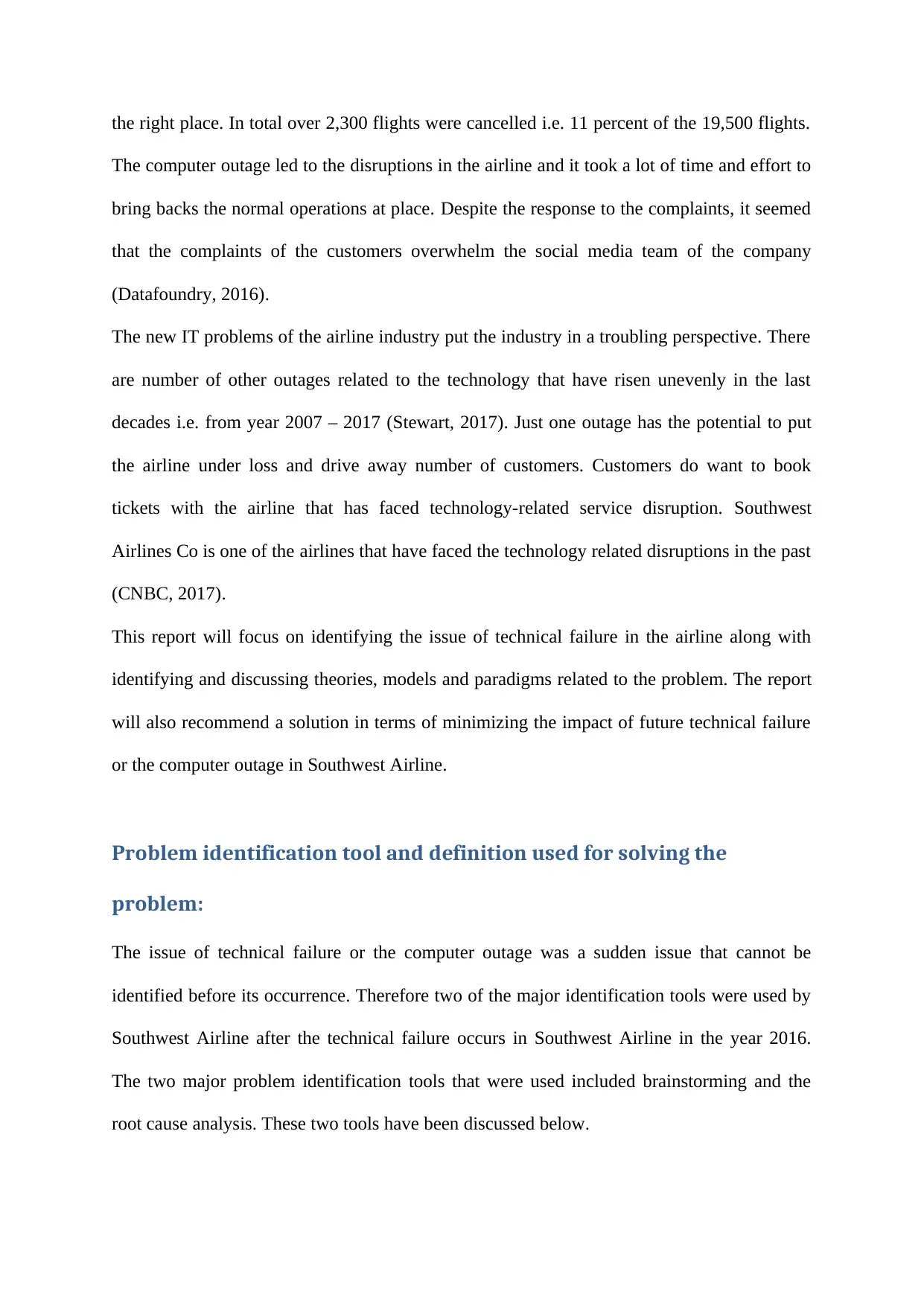
the right place. In total over 2,300 flights were cancelled i.e. 11 percent of the 19,500 flights.
The computer outage led to the disruptions in the airline and it took a lot of time and effort to
bring backs the normal operations at place. Despite the response to the complaints, it seemed
that the complaints of the customers overwhelm the social media team of the company
(Datafoundry, 2016).
The new IT problems of the airline industry put the industry in a troubling perspective. There
are number of other outages related to the technology that have risen unevenly in the last
decades i.e. from year 2007 – 2017 (Stewart, 2017). Just one outage has the potential to put
the airline under loss and drive away number of customers. Customers do want to book
tickets with the airline that has faced technology-related service disruption. Southwest
Airlines Co is one of the airlines that have faced the technology related disruptions in the past
(CNBC, 2017).
This report will focus on identifying the issue of technical failure in the airline along with
identifying and discussing theories, models and paradigms related to the problem. The report
will also recommend a solution in terms of minimizing the impact of future technical failure
or the computer outage in Southwest Airline.
Problem identification tool and definition used for solving the
problem:
The issue of technical failure or the computer outage was a sudden issue that cannot be
identified before its occurrence. Therefore two of the major identification tools were used by
Southwest Airline after the technical failure occurs in Southwest Airline in the year 2016.
The two major problem identification tools that were used included brainstorming and the
root cause analysis. These two tools have been discussed below.
The computer outage led to the disruptions in the airline and it took a lot of time and effort to
bring backs the normal operations at place. Despite the response to the complaints, it seemed
that the complaints of the customers overwhelm the social media team of the company
(Datafoundry, 2016).
The new IT problems of the airline industry put the industry in a troubling perspective. There
are number of other outages related to the technology that have risen unevenly in the last
decades i.e. from year 2007 – 2017 (Stewart, 2017). Just one outage has the potential to put
the airline under loss and drive away number of customers. Customers do want to book
tickets with the airline that has faced technology-related service disruption. Southwest
Airlines Co is one of the airlines that have faced the technology related disruptions in the past
(CNBC, 2017).
This report will focus on identifying the issue of technical failure in the airline along with
identifying and discussing theories, models and paradigms related to the problem. The report
will also recommend a solution in terms of minimizing the impact of future technical failure
or the computer outage in Southwest Airline.
Problem identification tool and definition used for solving the
problem:
The issue of technical failure or the computer outage was a sudden issue that cannot be
identified before its occurrence. Therefore two of the major identification tools were used by
Southwest Airline after the technical failure occurs in Southwest Airline in the year 2016.
The two major problem identification tools that were used included brainstorming and the
root cause analysis. These two tools have been discussed below.
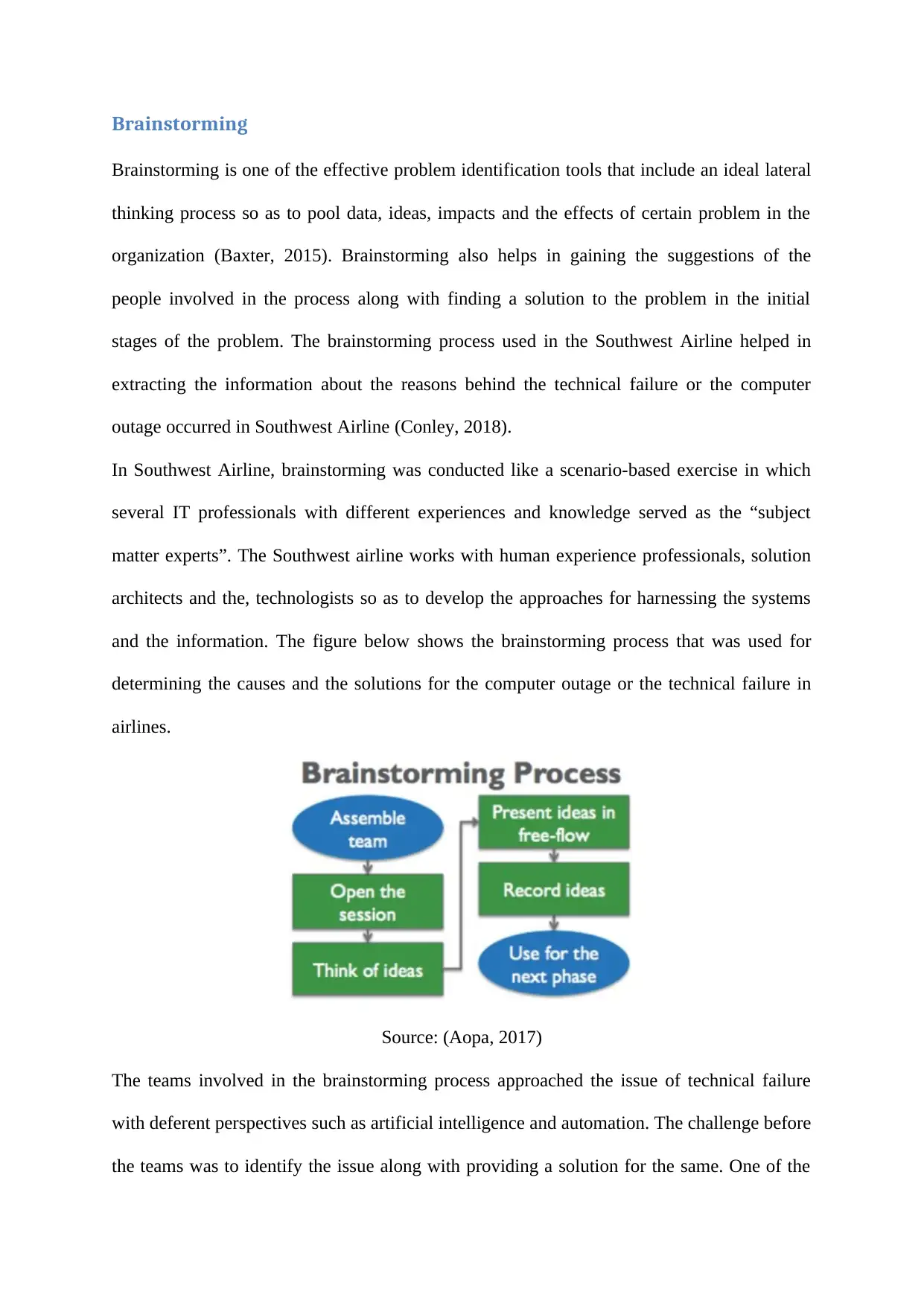
Brainstorming
Brainstorming is one of the effective problem identification tools that include an ideal lateral
thinking process so as to pool data, ideas, impacts and the effects of certain problem in the
organization (Baxter, 2015). Brainstorming also helps in gaining the suggestions of the
people involved in the process along with finding a solution to the problem in the initial
stages of the problem. The brainstorming process used in the Southwest Airline helped in
extracting the information about the reasons behind the technical failure or the computer
outage occurred in Southwest Airline (Conley, 2018).
In Southwest Airline, brainstorming was conducted like a scenario-based exercise in which
several IT professionals with different experiences and knowledge served as the “subject
matter experts”. The Southwest airline works with human experience professionals, solution
architects and the, technologists so as to develop the approaches for harnessing the systems
and the information. The figure below shows the brainstorming process that was used for
determining the causes and the solutions for the computer outage or the technical failure in
airlines.
Source: (Aopa, 2017)
The teams involved in the brainstorming process approached the issue of technical failure
with deferent perspectives such as artificial intelligence and automation. The challenge before
the teams was to identify the issue along with providing a solution for the same. One of the
Brainstorming is one of the effective problem identification tools that include an ideal lateral
thinking process so as to pool data, ideas, impacts and the effects of certain problem in the
organization (Baxter, 2015). Brainstorming also helps in gaining the suggestions of the
people involved in the process along with finding a solution to the problem in the initial
stages of the problem. The brainstorming process used in the Southwest Airline helped in
extracting the information about the reasons behind the technical failure or the computer
outage occurred in Southwest Airline (Conley, 2018).
In Southwest Airline, brainstorming was conducted like a scenario-based exercise in which
several IT professionals with different experiences and knowledge served as the “subject
matter experts”. The Southwest airline works with human experience professionals, solution
architects and the, technologists so as to develop the approaches for harnessing the systems
and the information. The figure below shows the brainstorming process that was used for
determining the causes and the solutions for the computer outage or the technical failure in
airlines.
Source: (Aopa, 2017)
The teams involved in the brainstorming process approached the issue of technical failure
with deferent perspectives such as artificial intelligence and automation. The challenge before
the teams was to identify the issue along with providing a solution for the same. One of the
⊘ This is a preview!⊘
Do you want full access?
Subscribe today to unlock all pages.

Trusted by 1+ million students worldwide
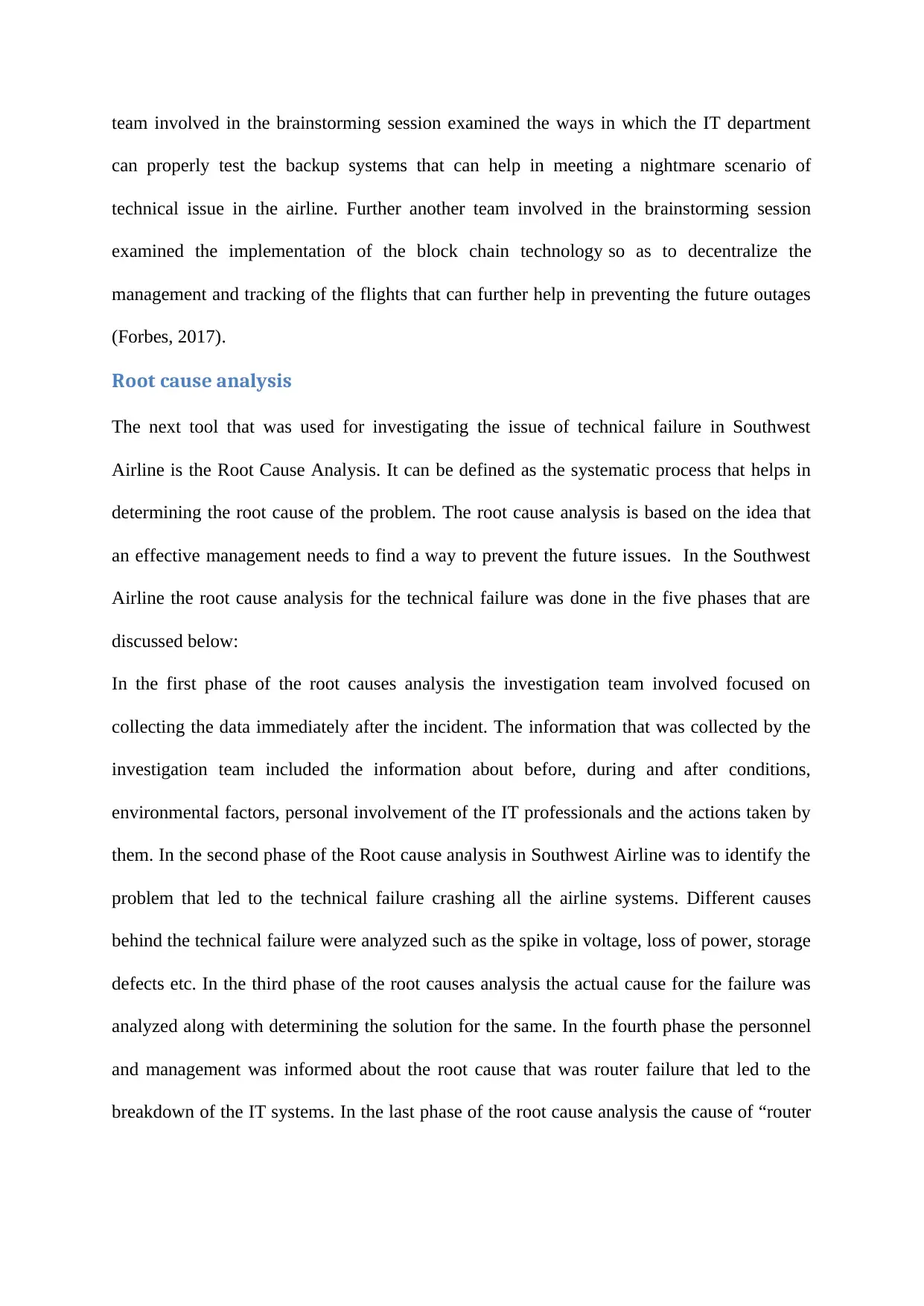
team involved in the brainstorming session examined the ways in which the IT department
can properly test the backup systems that can help in meeting a nightmare scenario of
technical issue in the airline. Further another team involved in the brainstorming session
examined the implementation of the block chain technology so as to decentralize the
management and tracking of the flights that can further help in preventing the future outages
(Forbes, 2017).
Root cause analysis
The next tool that was used for investigating the issue of technical failure in Southwest
Airline is the Root Cause Analysis. It can be defined as the systematic process that helps in
determining the root cause of the problem. The root cause analysis is based on the idea that
an effective management needs to find a way to prevent the future issues. In the Southwest
Airline the root cause analysis for the technical failure was done in the five phases that are
discussed below:
In the first phase of the root causes analysis the investigation team involved focused on
collecting the data immediately after the incident. The information that was collected by the
investigation team included the information about before, during and after conditions,
environmental factors, personal involvement of the IT professionals and the actions taken by
them. In the second phase of the Root cause analysis in Southwest Airline was to identify the
problem that led to the technical failure crashing all the airline systems. Different causes
behind the technical failure were analyzed such as the spike in voltage, loss of power, storage
defects etc. In the third phase of the root causes analysis the actual cause for the failure was
analyzed along with determining the solution for the same. In the fourth phase the personnel
and management was informed about the root cause that was router failure that led to the
breakdown of the IT systems. In the last phase of the root cause analysis the cause of “router
can properly test the backup systems that can help in meeting a nightmare scenario of
technical issue in the airline. Further another team involved in the brainstorming session
examined the implementation of the block chain technology so as to decentralize the
management and tracking of the flights that can further help in preventing the future outages
(Forbes, 2017).
Root cause analysis
The next tool that was used for investigating the issue of technical failure in Southwest
Airline is the Root Cause Analysis. It can be defined as the systematic process that helps in
determining the root cause of the problem. The root cause analysis is based on the idea that
an effective management needs to find a way to prevent the future issues. In the Southwest
Airline the root cause analysis for the technical failure was done in the five phases that are
discussed below:
In the first phase of the root causes analysis the investigation team involved focused on
collecting the data immediately after the incident. The information that was collected by the
investigation team included the information about before, during and after conditions,
environmental factors, personal involvement of the IT professionals and the actions taken by
them. In the second phase of the Root cause analysis in Southwest Airline was to identify the
problem that led to the technical failure crashing all the airline systems. Different causes
behind the technical failure were analyzed such as the spike in voltage, loss of power, storage
defects etc. In the third phase of the root causes analysis the actual cause for the failure was
analyzed along with determining the solution for the same. In the fourth phase the personnel
and management was informed about the root cause that was router failure that led to the
breakdown of the IT systems. In the last phase of the root cause analysis the cause of “router
Paraphrase This Document
Need a fresh take? Get an instant paraphrase of this document with our AI Paraphraser
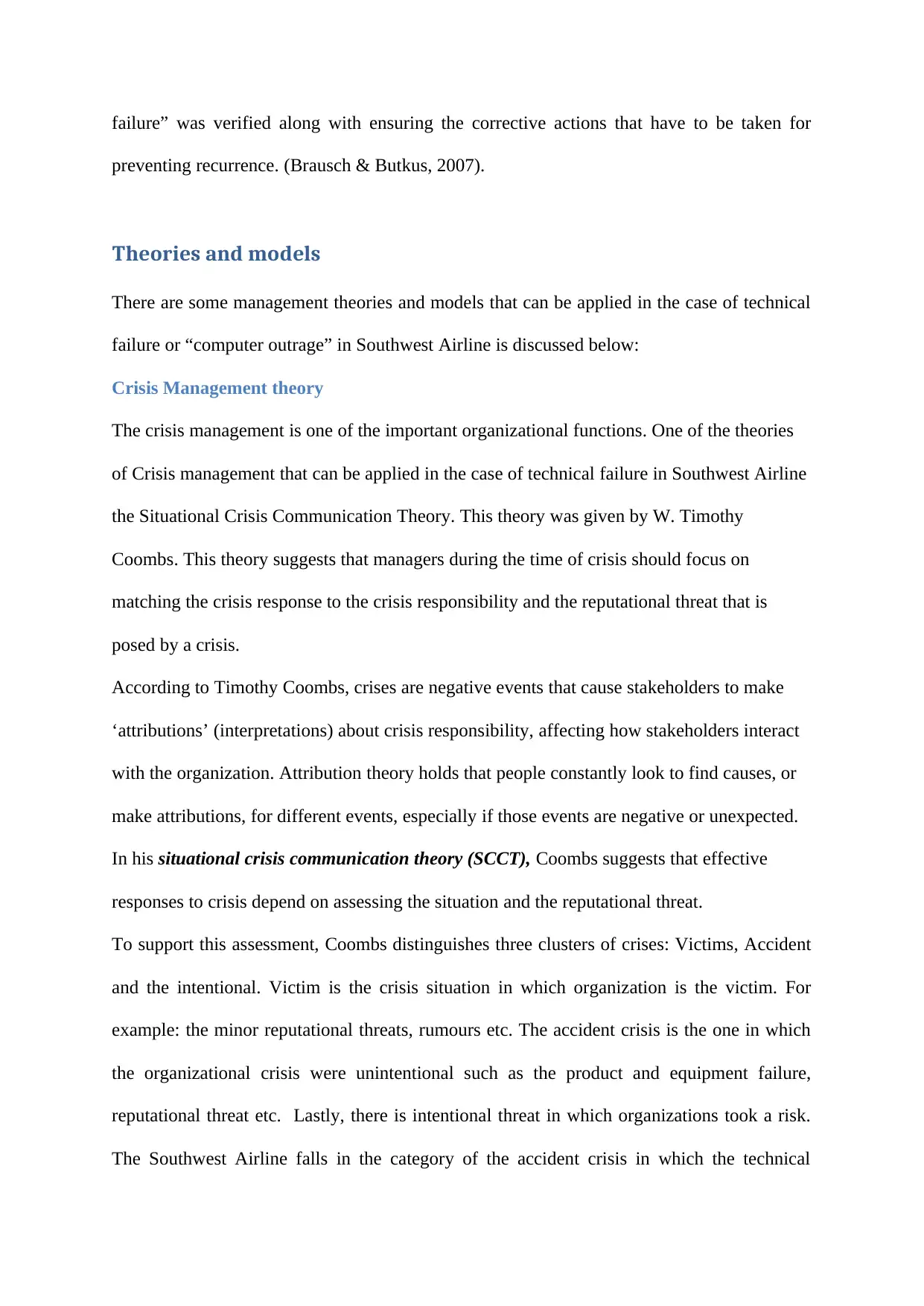
failure” was verified along with ensuring the corrective actions that have to be taken for
preventing recurrence. (Brausch & Butkus, 2007).
Theories and models
There are some management theories and models that can be applied in the case of technical
failure or “computer outrage” in Southwest Airline is discussed below:
Crisis Management theory
The crisis management is one of the important organizational functions. One of the theories
of Crisis management that can be applied in the case of technical failure in Southwest Airline
the Situational Crisis Communication Theory. This theory was given by W. Timothy
Coombs. This theory suggests that managers during the time of crisis should focus on
matching the crisis response to the crisis responsibility and the reputational threat that is
posed by a crisis.
According to Timothy Coombs, crises are negative events that cause stakeholders to make
‘attributions’ (interpretations) about crisis responsibility, affecting how stakeholders interact
with the organization. Attribution theory holds that people constantly look to find causes, or
make attributions, for different events, especially if those events are negative or unexpected.
In his situational crisis communication theory (SCCT), Coombs suggests that effective
responses to crisis depend on assessing the situation and the reputational threat.
To support this assessment, Coombs distinguishes three clusters of crises: Victims, Accident
and the intentional. Victim is the crisis situation in which organization is the victim. For
example: the minor reputational threats, rumours etc. The accident crisis is the one in which
the organizational crisis were unintentional such as the product and equipment failure,
reputational threat etc. Lastly, there is intentional threat in which organizations took a risk.
The Southwest Airline falls in the category of the accident crisis in which the technical
preventing recurrence. (Brausch & Butkus, 2007).
Theories and models
There are some management theories and models that can be applied in the case of technical
failure or “computer outrage” in Southwest Airline is discussed below:
Crisis Management theory
The crisis management is one of the important organizational functions. One of the theories
of Crisis management that can be applied in the case of technical failure in Southwest Airline
the Situational Crisis Communication Theory. This theory was given by W. Timothy
Coombs. This theory suggests that managers during the time of crisis should focus on
matching the crisis response to the crisis responsibility and the reputational threat that is
posed by a crisis.
According to Timothy Coombs, crises are negative events that cause stakeholders to make
‘attributions’ (interpretations) about crisis responsibility, affecting how stakeholders interact
with the organization. Attribution theory holds that people constantly look to find causes, or
make attributions, for different events, especially if those events are negative or unexpected.
In his situational crisis communication theory (SCCT), Coombs suggests that effective
responses to crisis depend on assessing the situation and the reputational threat.
To support this assessment, Coombs distinguishes three clusters of crises: Victims, Accident
and the intentional. Victim is the crisis situation in which organization is the victim. For
example: the minor reputational threats, rumours etc. The accident crisis is the one in which
the organizational crisis were unintentional such as the product and equipment failure,
reputational threat etc. Lastly, there is intentional threat in which organizations took a risk.
The Southwest Airline falls in the category of the accident crisis in which the technical
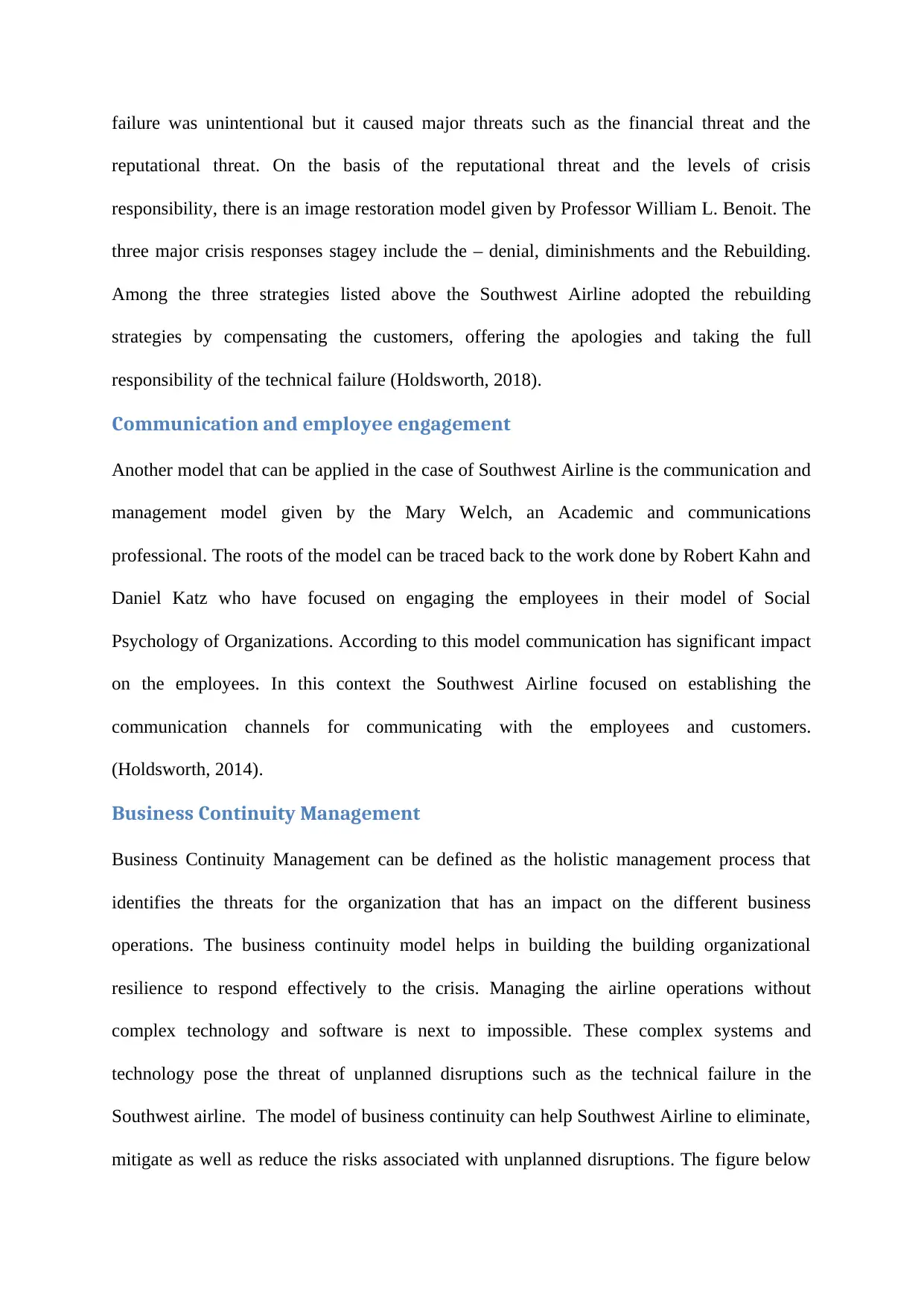
failure was unintentional but it caused major threats such as the financial threat and the
reputational threat. On the basis of the reputational threat and the levels of crisis
responsibility, there is an image restoration model given by Professor William L. Benoit. The
three major crisis responses stagey include the – denial, diminishments and the Rebuilding.
Among the three strategies listed above the Southwest Airline adopted the rebuilding
strategies by compensating the customers, offering the apologies and taking the full
responsibility of the technical failure (Holdsworth, 2018).
Communication and employee engagement
Another model that can be applied in the case of Southwest Airline is the communication and
management model given by the Mary Welch, an Academic and communications
professional. The roots of the model can be traced back to the work done by Robert Kahn and
Daniel Katz who have focused on engaging the employees in their model of Social
Psychology of Organizations. According to this model communication has significant impact
on the employees. In this context the Southwest Airline focused on establishing the
communication channels for communicating with the employees and customers.
(Holdsworth, 2014).
Business Continuity Management
Business Continuity Management can be defined as the holistic management process that
identifies the threats for the organization that has an impact on the different business
operations. The business continuity model helps in building the building organizational
resilience to respond effectively to the crisis. Managing the airline operations without
complex technology and software is next to impossible. These complex systems and
technology pose the threat of unplanned disruptions such as the technical failure in the
Southwest airline. The model of business continuity can help Southwest Airline to eliminate,
mitigate as well as reduce the risks associated with unplanned disruptions. The figure below
reputational threat. On the basis of the reputational threat and the levels of crisis
responsibility, there is an image restoration model given by Professor William L. Benoit. The
three major crisis responses stagey include the – denial, diminishments and the Rebuilding.
Among the three strategies listed above the Southwest Airline adopted the rebuilding
strategies by compensating the customers, offering the apologies and taking the full
responsibility of the technical failure (Holdsworth, 2018).
Communication and employee engagement
Another model that can be applied in the case of Southwest Airline is the communication and
management model given by the Mary Welch, an Academic and communications
professional. The roots of the model can be traced back to the work done by Robert Kahn and
Daniel Katz who have focused on engaging the employees in their model of Social
Psychology of Organizations. According to this model communication has significant impact
on the employees. In this context the Southwest Airline focused on establishing the
communication channels for communicating with the employees and customers.
(Holdsworth, 2014).
Business Continuity Management
Business Continuity Management can be defined as the holistic management process that
identifies the threats for the organization that has an impact on the different business
operations. The business continuity model helps in building the building organizational
resilience to respond effectively to the crisis. Managing the airline operations without
complex technology and software is next to impossible. These complex systems and
technology pose the threat of unplanned disruptions such as the technical failure in the
Southwest airline. The model of business continuity can help Southwest Airline to eliminate,
mitigate as well as reduce the risks associated with unplanned disruptions. The figure below
⊘ This is a preview!⊘
Do you want full access?
Subscribe today to unlock all pages.

Trusted by 1+ million students worldwide
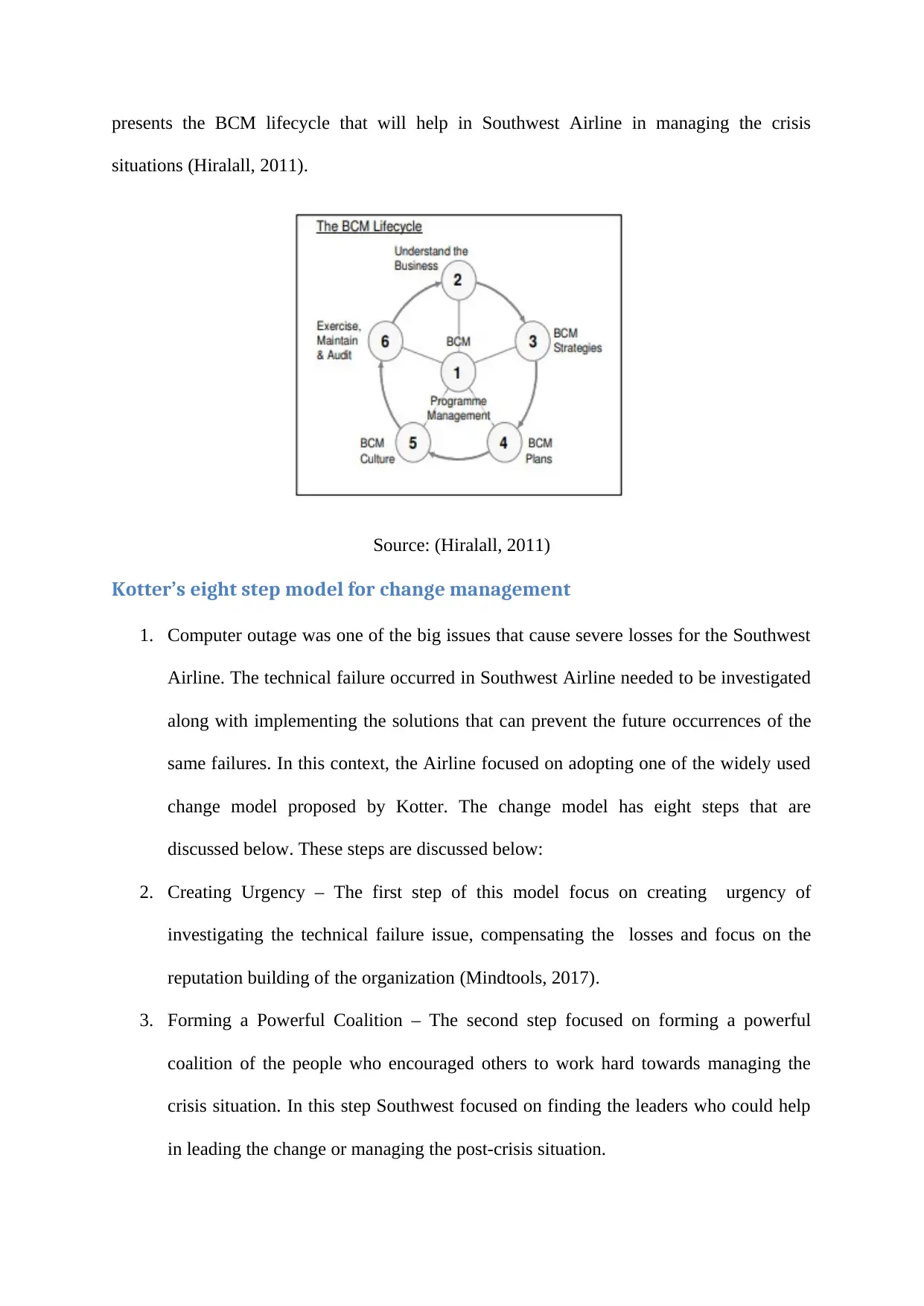
presents the BCM lifecycle that will help in Southwest Airline in managing the crisis
situations (Hiralall, 2011).
Source: (Hiralall, 2011)
Kotter’s eight step model for change management
1. Computer outage was one of the big issues that cause severe losses for the Southwest
Airline. The technical failure occurred in Southwest Airline needed to be investigated
along with implementing the solutions that can prevent the future occurrences of the
same failures. In this context, the Airline focused on adopting one of the widely used
change model proposed by Kotter. The change model has eight steps that are
discussed below. These steps are discussed below:
2. Creating Urgency – The first step of this model focus on creating urgency of
investigating the technical failure issue, compensating the losses and focus on the
reputation building of the organization (Mindtools, 2017).
3. Forming a Powerful Coalition – The second step focused on forming a powerful
coalition of the people who encouraged others to work hard towards managing the
crisis situation. In this step Southwest focused on finding the leaders who could help
in leading the change or managing the post-crisis situation.
situations (Hiralall, 2011).
Source: (Hiralall, 2011)
Kotter’s eight step model for change management
1. Computer outage was one of the big issues that cause severe losses for the Southwest
Airline. The technical failure occurred in Southwest Airline needed to be investigated
along with implementing the solutions that can prevent the future occurrences of the
same failures. In this context, the Airline focused on adopting one of the widely used
change model proposed by Kotter. The change model has eight steps that are
discussed below. These steps are discussed below:
2. Creating Urgency – The first step of this model focus on creating urgency of
investigating the technical failure issue, compensating the losses and focus on the
reputation building of the organization (Mindtools, 2017).
3. Forming a Powerful Coalition – The second step focused on forming a powerful
coalition of the people who encouraged others to work hard towards managing the
crisis situation. In this step Southwest focused on finding the leaders who could help
in leading the change or managing the post-crisis situation.
Paraphrase This Document
Need a fresh take? Get an instant paraphrase of this document with our AI Paraphraser
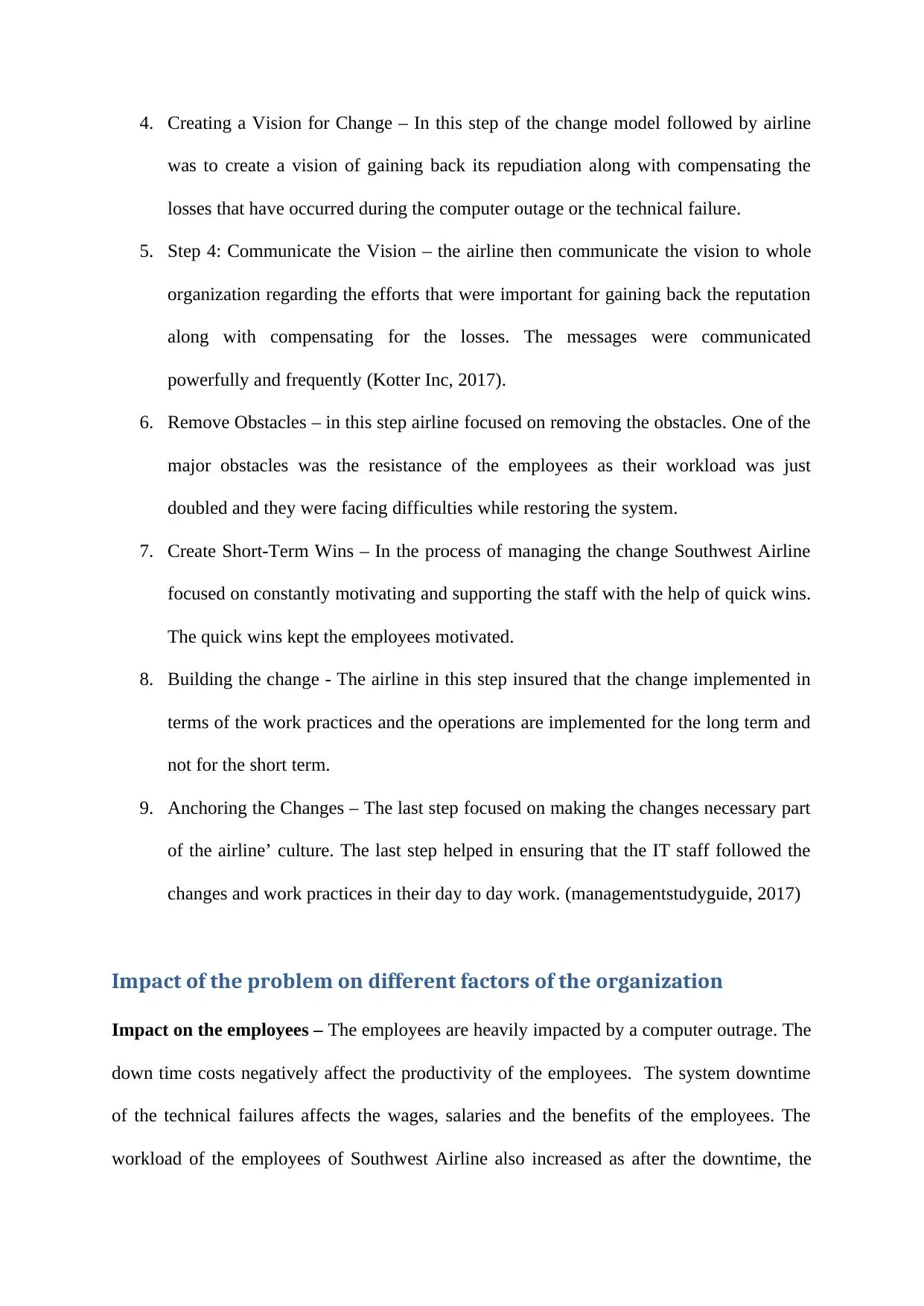
4. Creating a Vision for Change – In this step of the change model followed by airline
was to create a vision of gaining back its repudiation along with compensating the
losses that have occurred during the computer outage or the technical failure.
5. Step 4: Communicate the Vision – the airline then communicate the vision to whole
organization regarding the efforts that were important for gaining back the reputation
along with compensating for the losses. The messages were communicated
powerfully and frequently (Kotter Inc, 2017).
6. Remove Obstacles – in this step airline focused on removing the obstacles. One of the
major obstacles was the resistance of the employees as their workload was just
doubled and they were facing difficulties while restoring the system.
7. Create Short-Term Wins – In the process of managing the change Southwest Airline
focused on constantly motivating and supporting the staff with the help of quick wins.
The quick wins kept the employees motivated.
8. Building the change - The airline in this step insured that the change implemented in
terms of the work practices and the operations are implemented for the long term and
not for the short term.
9. Anchoring the Changes – The last step focused on making the changes necessary part
of the airline’ culture. The last step helped in ensuring that the IT staff followed the
changes and work practices in their day to day work. (managementstudyguide, 2017)
Impact of the problem on different factors of the organization
Impact on the employees – The employees are heavily impacted by a computer outrage. The
down time costs negatively affect the productivity of the employees. The system downtime
of the technical failures affects the wages, salaries and the benefits of the employees. The
workload of the employees of Southwest Airline also increased as after the downtime, the
was to create a vision of gaining back its repudiation along with compensating the
losses that have occurred during the computer outage or the technical failure.
5. Step 4: Communicate the Vision – the airline then communicate the vision to whole
organization regarding the efforts that were important for gaining back the reputation
along with compensating for the losses. The messages were communicated
powerfully and frequently (Kotter Inc, 2017).
6. Remove Obstacles – in this step airline focused on removing the obstacles. One of the
major obstacles was the resistance of the employees as their workload was just
doubled and they were facing difficulties while restoring the system.
7. Create Short-Term Wins – In the process of managing the change Southwest Airline
focused on constantly motivating and supporting the staff with the help of quick wins.
The quick wins kept the employees motivated.
8. Building the change - The airline in this step insured that the change implemented in
terms of the work practices and the operations are implemented for the long term and
not for the short term.
9. Anchoring the Changes – The last step focused on making the changes necessary part
of the airline’ culture. The last step helped in ensuring that the IT staff followed the
changes and work practices in their day to day work. (managementstudyguide, 2017)
Impact of the problem on different factors of the organization
Impact on the employees – The employees are heavily impacted by a computer outrage. The
down time costs negatively affect the productivity of the employees. The system downtime
of the technical failures affects the wages, salaries and the benefits of the employees. The
workload of the employees of Southwest Airline also increased as after the downtime, the
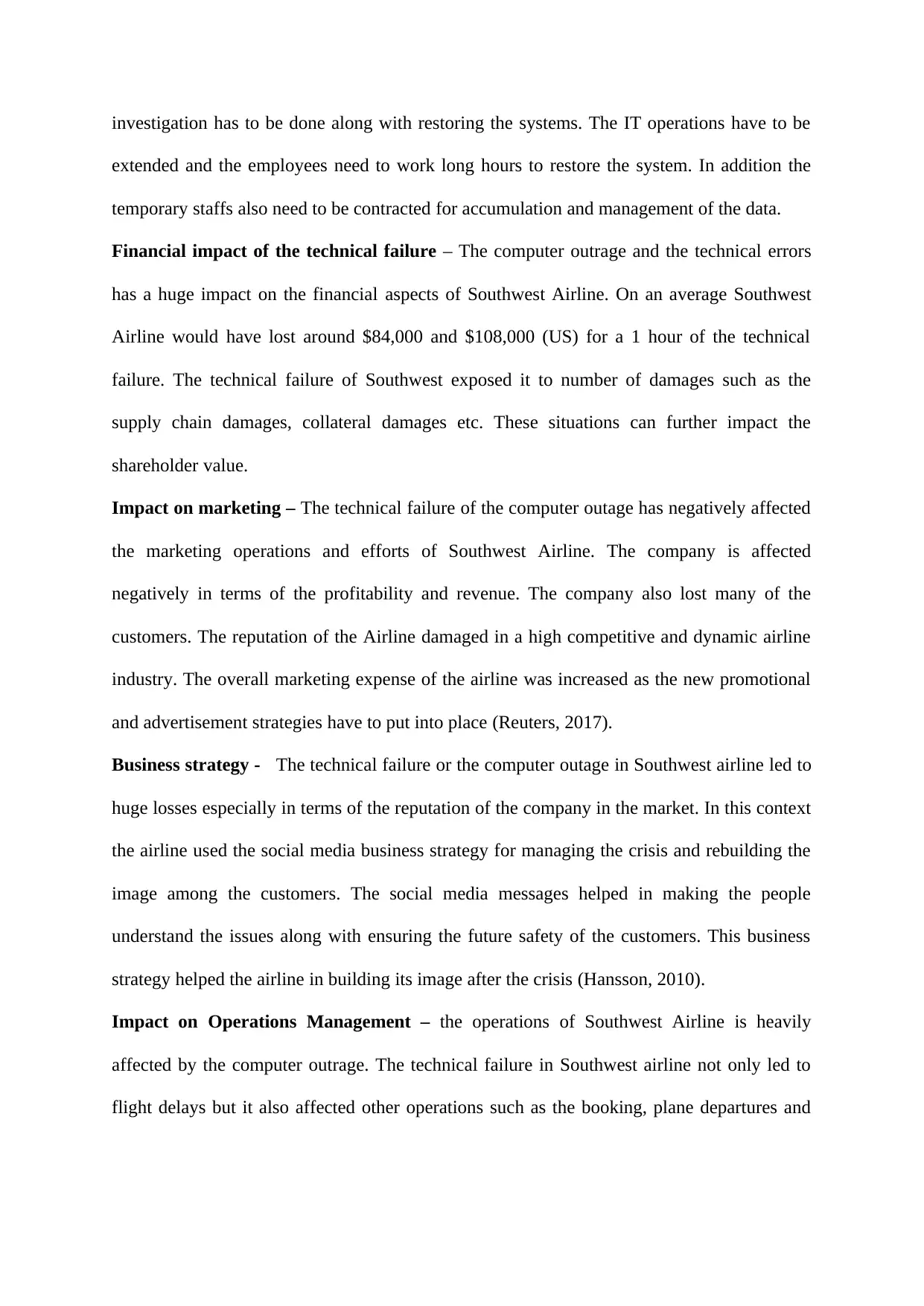
investigation has to be done along with restoring the systems. The IT operations have to be
extended and the employees need to work long hours to restore the system. In addition the
temporary staffs also need to be contracted for accumulation and management of the data.
Financial impact of the technical failure – The computer outrage and the technical errors
has a huge impact on the financial aspects of Southwest Airline. On an average Southwest
Airline would have lost around $84,000 and $108,000 (US) for a 1 hour of the technical
failure. The technical failure of Southwest exposed it to number of damages such as the
supply chain damages, collateral damages etc. These situations can further impact the
shareholder value.
Impact on marketing – The technical failure of the computer outage has negatively affected
the marketing operations and efforts of Southwest Airline. The company is affected
negatively in terms of the profitability and revenue. The company also lost many of the
customers. The reputation of the Airline damaged in a high competitive and dynamic airline
industry. The overall marketing expense of the airline was increased as the new promotional
and advertisement strategies have to put into place (Reuters, 2017).
Business strategy - The technical failure or the computer outage in Southwest airline led to
huge losses especially in terms of the reputation of the company in the market. In this context
the airline used the social media business strategy for managing the crisis and rebuilding the
image among the customers. The social media messages helped in making the people
understand the issues along with ensuring the future safety of the customers. This business
strategy helped the airline in building its image after the crisis (Hansson, 2010).
Impact on Operations Management – the operations of Southwest Airline is heavily
affected by the computer outrage. The technical failure in Southwest airline not only led to
flight delays but it also affected other operations such as the booking, plane departures and
extended and the employees need to work long hours to restore the system. In addition the
temporary staffs also need to be contracted for accumulation and management of the data.
Financial impact of the technical failure – The computer outrage and the technical errors
has a huge impact on the financial aspects of Southwest Airline. On an average Southwest
Airline would have lost around $84,000 and $108,000 (US) for a 1 hour of the technical
failure. The technical failure of Southwest exposed it to number of damages such as the
supply chain damages, collateral damages etc. These situations can further impact the
shareholder value.
Impact on marketing – The technical failure of the computer outage has negatively affected
the marketing operations and efforts of Southwest Airline. The company is affected
negatively in terms of the profitability and revenue. The company also lost many of the
customers. The reputation of the Airline damaged in a high competitive and dynamic airline
industry. The overall marketing expense of the airline was increased as the new promotional
and advertisement strategies have to put into place (Reuters, 2017).
Business strategy - The technical failure or the computer outage in Southwest airline led to
huge losses especially in terms of the reputation of the company in the market. In this context
the airline used the social media business strategy for managing the crisis and rebuilding the
image among the customers. The social media messages helped in making the people
understand the issues along with ensuring the future safety of the customers. This business
strategy helped the airline in building its image after the crisis (Hansson, 2010).
Impact on Operations Management – the operations of Southwest Airline is heavily
affected by the computer outrage. The technical failure in Southwest airline not only led to
flight delays but it also affected other operations such as the booking, plane departures and
⊘ This is a preview!⊘
Do you want full access?
Subscribe today to unlock all pages.

Trusted by 1+ million students worldwide
1 out of 17
Related Documents
Your All-in-One AI-Powered Toolkit for Academic Success.
+13062052269
info@desklib.com
Available 24*7 on WhatsApp / Email
![[object Object]](/_next/static/media/star-bottom.7253800d.svg)
Unlock your academic potential
Copyright © 2020–2025 A2Z Services. All Rights Reserved. Developed and managed by ZUCOL.



